Countries around the world have committed to protecting 10 percent of the planet’s coastal and marine areas by 2020 as part of the United Nations’ Sustainable Development Goals. But it is not always easy for countries to agree on where the protected areas should be so they have the biggest conservation impact.
In a ministerial declaration issued today at the closing of the 17th Ordinary Session of the African Ministerial Conference on the Environment (AMCEN), African governments agreed to make the Conference the forum for making regional environment policies with effective mechanisms for implementation.
When most people think about beach trash, they envision the rare plastic bag, glass bottle, cigarette butt or leftover beach supply. It’s something locals shake their heads about and (sometimes) throw away on their way out. It’s a bit rude, a bit lazy – but by no means extraordinary.
A scientific paper for the High Level Panel for a Sustainable Ocean Economy has found that, with better management and technological innovation, the ocean could provide over six times more food than it does today.
It is 8.10 am. The tide is low in Bodo village nestled in a bay on the shores of the Indian Ocean in Kwale County on Kenya’s South Coast.
The World Migratory Bird Day (WMBD), celebrated every year in May and October seeks to raise awareness on migratory birds and the need to conserve them. These birds travel over thousands of kilometres, in search of suitable conditions for feeding and breeding.
- Barren seas: Once-teeming waters off KwaZulu-Natal show few signs of ocean life
- Kenya-based enterprise that transforms flip-flop pollution into art launches in Ponte Vedra Beach
- Sheppie Snippets: Conservancy holds AGM
- Ocean plastic: Abandoned fishing nets are endangering marine animals
- Lofoten-Based Companies Receive Millions to Clean Up Marine Plastic Pollution






